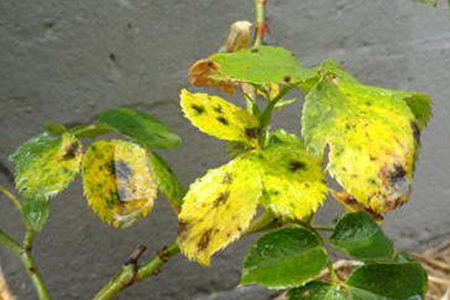
HOW TO CONTROL BLACK SPOT FUNGUS DISEASE ON ROSES
Black spot (blackspot) is one of the most common diseases of rose bushes; and, if left unchecked, it can cause quite a bit of damage to your rose garden. Caused by the fungus Diplocarpon rosae, black spot begins just as its name suggests, with black spots showing up on the surface of the leaves.
As the spots grow larger, they become ringed with yellow, eventually causing the whole leaf to turn yellow and fall off. The stems may also have black or purplish spots. If not treated, black spot will leave your rose garden not only naked, but significantly weakened and unprepared for the next winter.
Like most fungal diseases, black spot thrives in wet, humid weather, usually when temperatures are in the mid-70s F. The spots produce spores which spread to other leaves and plants. The spores can survive the winter in fallen leaves and infected canes.
Leaves on roses with black spot eventually turn yellow and fall off.
While black spot may seem relentless in your rose garden, it’s actually fairly easy to manage with the right treatment and prevention strategies. Here’s how to control black spot in your garden.
How to Treat Black Spot
If you’ve noticed telltale black spots on your roses, you should:
Remove Infection
Prune away the infected leaves and infected stems. Also, rake up all the fallen leaves under the plant. Throw the infected debris away, rather than putting it on your compost pile.
Spray Roses
Neem oil fungicide for black spot.
Once the infected leaves and stems have been removed, treat your rose with a fungicide. Spray the entire plant, making sure to get the tops and bottoms of the leaves as well as the stems. You can use a chemical fungicide or any number of organic options such as:
-
Copper
-
Lime Sulfur
-
Neem Oil
-
Potassium or Ammonium Bicarbonate
-
Sulfur
How to Prevent Black Spot
With the right gardening habits in place, you can keep black spot at bay on your roses by:
-
Water in the Morning: This allows the moisture to evaporate from the leaves.
-
Avoid Watering Foliage: Especially if the weather is warm and humid, avoid getting the foliage wet when watering.
-
Choose Resistant Roses: Some varieties of rose are resistant to black spot.
-
Allow Air Circulation: Choose a planting site with plenty of air circulation, and be sure to space your roses 3-4 feet apart. Prune dense bushes to let air circulate between the branches.
Discard fallen leaves under rose bushes.
-
Choose Sunny Location: Roses prefer full sun anyway, and choosing a sunny location for your rose garden will help burn off moisture.
-
Keep Garden Clean: Regularly rake and clean up around your roses, and throw away any fallen leaves. This is especially important in fall and winter, to remove spores that might be awaiting the spring warm-up to become active. After the cold-weather cleanup, apply fresh mulch to keep any remaining spores away from your roses.
-
Stay Alert: Inspect your roses regularly, and immediately remove and throw away any spotted leaves, both on the plant and on the ground. If the problem isn’t severe, this may be all the treatment you need.
-
Preventative Treatment: If black spot is a perennial problem in your yard, begin a preventative treatment with an organic, nontoxic, fungicidal spray (such as those on the list above), right before your roses sprout in spring. Continue treatment every couple of weeks to keep the fungus under control.


